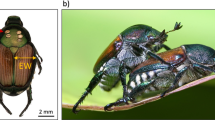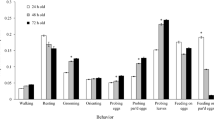Abstract
ACCORDING to Imms1 tingid bugs insert their eggs into plant tissue. Patel and Kulkarny2, who studied the bionomics of the brinjal tingid, Urentius echinus Dist., and Sharga3 and Samuel4, who studied the egglaying habit of Monanthia globulifera Wlk., merely state that the eggs are inserted into the leaf tissue; none of these workers describes the actual way in which the eggs are thrust into the plant tissue and what precedes the deposition of eggs. The purpose of the present communication is to describe an appar ently unknown series of actions on the part of the female tingid, culminating in the deposition of an egg, which is invariably preceded by extensive probing and actual marking by the rostrum.
Similar content being viewed by others
References
Imms, A. D., “A General Text Book of Entomology” (Methuen, London, 1957).
Patel, R. C., and Kulkarny, H. L., J. Bomb. Nat. Hist. Soc., 53, (1) 86 (1955).
Sharga, U. S., ibid., 51, 885 (1953).
Samuel, C. K., Indian J. Ent., 1 (3), 98 (1939).
Author information
Authors and Affiliations
Rights and permissions
About this article
Cite this article
THONTADARYA, T., CHANNA BASAVANNA, G. Mode of Egg Laying in Tingidae (Hemiptera). Nature 184, 289–290 (1959). https://doi.org/10.1038/184289a0
Issue Date:
DOI: https://doi.org/10.1038/184289a0
- Springer Nature Limited





